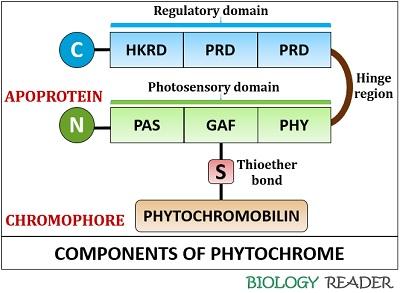Phytochrome in plants exists as a soluble protein pigment, which carries out photomorphogenic growth. It is present almost in all eukaryotic plants and first discovered by a scientist named Sterling Hendricks and Herry Borthwick in 1940-1960.
Warren Butler gave the term phytochrome. In 1983, Peter and Clark were the two scientists who introduced chemical purification of the phytochrome.
The gene sequence of phytochrome was reported in the year 1985 by two scientists Howard and Peter. This post describes the definition, features, structure, types, biosynthesis and functional role of the phytochrome.
Content: Phytochrome in Plants
Definition of Phytochrome
Phytochrome refers to the photoreceptor or photomorphogenic pigment, which absorbs red and far-red light wavelengths to induce photomorphogenesis or a light-induced growth and development in various plants, bacteria etc.
It merely refers to the light-activated switch, which turns on after absorbing the red light and turns off by absorbing far-red light. Phytochrome is the photosensitive proteinaceous pigment having a protein component and prosthetic group.
Features
Structure: Phytochrome consists of two elements; a protein part (apoprotein) and a prosthetic group (phytochromobilin or chromophore). Neither apoprotein nor chromophore absorbs the light alone, i.e. both should be present in combination to form a complete protein or holoprotein.
Synthesis: In plants, plastid synthesizes the chromophore component of phytochrome, while nuclear genome synthesizes the protein complex (apoprotein).
Structural conformation: It exists in two disparate structures like PR and PFR, in which a former is a cytosol associated, and a latter is membrane-associated. PR and PFR are the two forms of phytochromes that are generally photo-interchangeable.

Absorption spectra: PR absorbs red light, and PFR absorbs far-red light. Thus, phytochromes are photosensitive in nature, absorbing red light of wavelength ranging between 600-650 nm and far-red light of wavelength ranging between 700-750 nm.
Occurrence: In plants, phytochrome pigments can be found in different parts like roots, cotyledons, hypocotyls, epicotyls, coleoptile, stems etc.
Types: There are two classes of phytochrome protein, namely type-I and type-II. PHY-A, B, C, D and E are the phytochrome genes found in dicots, whereas PHY-A, B, C are common in monocots.
Functions: Phytochrome mediates various photoresponses like photoperiodism, phototropism, leaf senescence, abscission etc.
Phytochrome Structure
Phytochrome has a “dimeric” existence. It consists of homodimers, each of molecular weight 125 kDa. The conformation of phytochrome comprises two primary structural elements.

Phytochromobilin: It is a photopigment that appears as a linear tetrapyrrole structure. Phytochromobilin mainly absorbs red or far-red light at different wavelengths.
Apoprotein: It comprises two domains, one showing the photoreceptor activity and the other showing the kinase activity.
- Amino-terminal domain: It is the core photosensory domain that holds the chromophore and includes PAS, GAF and PHY subdomains. Sometimes, the N-terminal includes an additional variable, NTE (Amino-terminal extension). The PAS gene stabilizes the PFR form. GAF subdomain contains a cysteine residue to which a chromophore group binds via thioether linkage, and the PHY gene participates in the synthesis of phytochrome receptor proteins from mRNA.
- Carboxy-terminal domain: It is the regulatory domain, which primarily includes PAS repeats and HKRD subdomains. HKRD stands for a histidine-kinase related domain, which acts as a serine-threonine kinase and participates in the phytochrome signalling. PAS subdomain is responsible for phytochrome dimerization, and it also contains nucleolar organization signals.
Types of Phytochrome
PHY gene family encodes type-I and type-II phytochrome proteins.

- PHY-A gene encodes type-I phytochrome. It is a light-sensitive pigment, wherein the presence of light restricts the transcription of Phy. It only functions in the dark or becomes active by absorbing the far-red light. Type-I phytochromes occur in a majority of etiolated seedlings.
- PHY-B, C, D and E genes encode type-II phytochrome. It is a light stable pigment present in both light and dark-grown plants. It mainly functions in light or becomes active by absorbing the red light. Type-II phytochromes occur in a majority of green plants and seeds.
Biosynthesis of Phytochrome in Plants
Apoprotein component singly cannot absorb light wavelength. Phytochromobilin associates covalently to the apoprotein. Phytochromobilin pigment is primarily synthesized within the plastids and later liberated into the cytosol.
By the transcription of the nuclear genome into mRNA, a protein part (apoprotein) forms. Then, the 80-S ribosome translates the mRNA and synthesizes PR phytochrome in the cytoplasm. A chromophore pigment leaves the plastids and enters the cytosol.
Then, the association of the chromophore pigment and phytochrome protein occurs via bilin lyase activity of the GAF-domain through thioester linkage. Thus, the combination makes a holoprotein.
| Properties | PR | PFR |
|---|---|---|
| Colour | Blue green in colour | Light green in colour |
| Nature | Inactive | Active |
| light mediated response | It does not show photo-mediated responses | It mediates photomorphogenic responses |
| Maximum light absorption | In red region approximately at 680 nm | In far red region approximately at 730 nm |
| Conformational change | In red light, it transforms into PFR. | In far-red light, it transforms into PR. |
PR is the inactivated state of phytochrome, while PFR is the activated state. Activated phytochrome works as a serine-threonine kinase, which phosphorylates serine residue towards the hinge region.
Then on the phosphorylated region, the nucleolar organization signals get exposed, by which the PFR enters the nucleus and converts into a more stable phytochrome through protein phosphatase that removes the phosphate group.
Functional Role of Phytochrome in Plants
Phytochrome performs the following significant tasks:
Initiation of Transcription: Phytochrome triggers the exit of cop-1 or constitutive photomorphogenic 1 by activating three transcriptional factors like HF-1, LAF-1 and HY-5 in the presence of red light when the PR converts into active PFR.
Cop-1 is basically an E-3 ubiquitin ligase. Oppositely, the cop-1 remains inside the nucleus as an inactive form in darker conditions. It also targets the HY-5 transcriptional factor for the degradation by the 26S proteasome or inhibits the transcription.
Photomorphogenesis: Phytochrome carries out the light-mediated growth and developmental processes like seed germination, leaf growth, etiolation, photoperiodism, shade avoidance, flowering etc.
